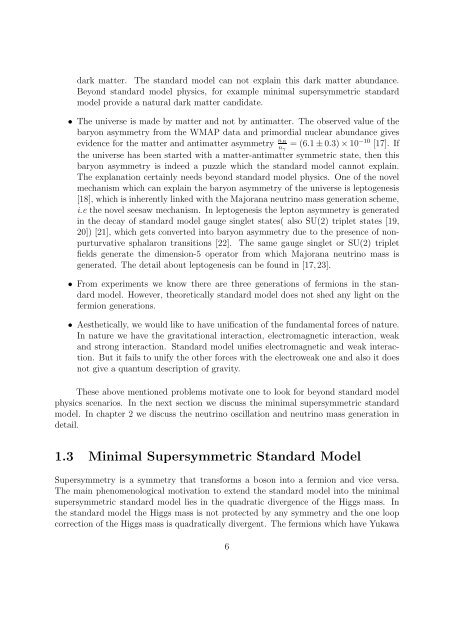PHYS08200604017 Manimala Mitra - Homi Bhabha National Institute
PHYS08200604017 Manimala Mitra - Homi Bhabha National Institute
PHYS08200604017 Manimala Mitra - Homi Bhabha National Institute
You also want an ePaper? Increase the reach of your titles
YUMPU automatically turns print PDFs into web optimized ePapers that Google loves.
dark matter. The standard model can not explain this dark matter abundance.<br />
Beyond standard model physics, for example minimal supersymmetric standard<br />
model provide a natural dark matter candidate.<br />
• The universe is made by matter and not by antimatter. The observed value of the<br />
baryon asymmetry from the WMAP data and primordial nuclear abundance gives<br />
evidence for the matter and antimatter asymmetry n B<br />
nγ<br />
= (6.1±0.3)×10 −10 [17]. If<br />
the universe has been started with a matter-antimatter symmetric state, then this<br />
baryon asymmetry is indeed a puzzle which the standard model cannot explain.<br />
The explanation certainly needs beyond standard model physics. One of the novel<br />
mechanism which can explain the baryon asymmetry of the universe is leptogenesis<br />
[18], which is inherently linked with the Majorana neutrino mass generation scheme,<br />
i.e the novel seesaw mechanism. In leptogenesis the lepton asymmetry is generated<br />
in the decay of standard model gauge singlet states( also SU(2) triplet states [19,<br />
20]) [21], which gets converted into baryon asymmetry due to the presence of nonpurturvative<br />
sphalaron transitions [22]. The same gauge singlet or SU(2) triplet<br />
fields generate the dimension-5 operator from which Majorana neutrino mass is<br />
generated. The detail about leptogenesis can be found in [17,23].<br />
• From experiments we know there are three generations of fermions in the standard<br />
model. However, theoretically standard model does not shed any light on the<br />
fermion generations.<br />
• Aesthetically, we would like to have unification of the fundamental forces of nature.<br />
In nature we have the gravitational interaction, electromagnetic interaction, weak<br />
and strong interaction. Standard model unifies electromagnetic and weak interaction.<br />
But it fails to unify the other forces with the electroweak one and also it does<br />
not give a quantum description of gravity.<br />
These above mentioned problems motivate one to look for beyond standard model<br />
physics scenarios. In the next section we discuss the minimal supersymmetric standard<br />
model. In chapter 2 we discuss the neutrino oscillation and neutrino mass generation in<br />
detail.<br />
1.3 Minimal Supersymmetric Standard Model<br />
Supersymmetry is a symmetry that transforms a boson into a fermion and vice versa.<br />
The main phenomenological motivation to extend the standard model into the minimal<br />
supersymmetric standard model lies in the quadratic divergence of the Higgs mass. In<br />
the standard model the Higgs mass is not protected by any symmetry and the one loop<br />
correction of the Higgs mass is quadratically divergent. The fermions which have Yukawa<br />
6
















